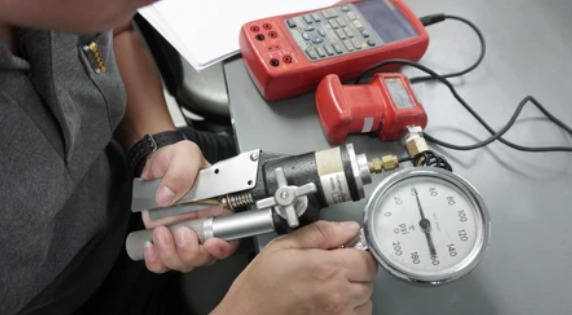In the ever-evolving world of engineering, precision is not just a requirement; it’s the cornerstone of success. One crucial component that engineers rely on to maintain this precision is the pressure gauge. A pressure gauge, especially in hydraulic systems, plays a pivotal role in ensuring smooth operations.
In this article, we delve deep into the realm of pressure gauge calibration, exploring the intricacies of hydraulic gauges, the meticulous process of calibration, and the importance of timely calibration to maintain system efficiency.
Understanding Hydraulic Gauges
Hydraulic gauges, also referred to as hydraulic pressure gauges, are indispensable devices used to measure the pressure exerted by a fluid within a hydraulic system. These gauges come in various types and sizes, each tailored for specific applications. The accuracy of a hydraulic gauge is paramount, as it directly influences the functionality and safety of the system it monitors.
Hydraulic systems are prevalent in various industries, including aerospace, automotive, and manufacturing. These systems rely on hydraulic gauges to precisely measure the pressure exerted by the hydraulic fluid. This measurement allows engineers and operators to monitor the system’s performance and make necessary adjustments to maintain efficiency and safety.
The Four Types of Pressure Gauges
➡ Bourdon Tube Gauges: Bourdon tube gauges are the most common and versatile type. They operate on the principle that a flattened tube tends to straighten when pressurized, which is then translated into a pressure reading. These gauges are widely used due to their accuracy and durability.
➡ Diaphragm Gauges: Diaphragm gauges utilize a flexible diaphragm that deforms under pressure, causing a pointer to move across a calibrated scale. They are often used in applications where Bourdon tube gauges might be unsuitable, such as measuring corrosive or viscous fluids.
➡ Bellows Gauges: Bellows gauges employ a convoluted tube known as a bellows, which expands or contracts based on pressure changes. This movement is transformed into mechanical motion, indicating the pressure. Bellows gauges are highly sensitive and find application in specialized industries requiring precise pressure measurements.
➡ Piston Gauges: Piston gauges use a piston and cylinder arrangement to measure pressure. When the pressure being measured is applied to the piston, it moves within the cylinder, and this movement is calibrated to provide the pressure reading. Piston gauges are exceptionally accurate and are often used in calibration laboratories.
How Do You Calibrate a Pressure Gauge?
Calibrating a pressure gauge is a meticulous process that demands expertise and precision. Proper calibration ensures that the gauge provides accurate readings, allowing engineers to make informed decisions. Here’s a step-by-step guide to calibrating a pressure gauge:
➡ Gather Necessary Equipment: To begin the calibration process, gather essential tools such as a reference gauge, a hydraulic hand pump, and a set of adapters compatible with the gauge.
➡ Stabilize the Environment: Ensure the calibration environment is stable. Any fluctuations in temperature or pressure can skew the calibration results.
➡ Connect the Gauges: Connect the pressure gauge to be calibrated with the reference gauge using appropriate adapters. Ensure a secure and leak-free connection.
➡ Apply Pressure: Using the hydraulic hand pump, apply a known pressure to both the gauge under calibration and the reference gauge. Note the readings on both gauges.
➡ Compare Readings: Carefully compare the readings on the gauge under calibration with the readings on the reference gauge. If there is a variance, adjust the calibration of the gauge accordingly until both readings align.
➡ Verify Zero Reading: After calibrating the gauge, ensure that it returns to zero when no pressure is applied. This step validates the gauge’s ability to reset accurately.
Calibration involves comparing the readings of the pressure gauge under calibration with those of a reference gauge, which is a gauge with a known accuracy. By applying known pressures and comparing the readings, engineers can adjust the gauge’s settings to ensure its accuracy.
When Should Pressure Gauges Be Calibrated?
Regular calibration of pressure gauges is not just a best practice; it’s a necessity. Timely calibration ensures the accuracy of readings and, consequently, the reliability of the entire hydraulic system. Here are the key instances when pressure gauges should be calibrated:
➡ Routine Maintenance: Include pressure gauge calibration as a part of the routine maintenance schedule. Regular checks guarantee that the gauge functions optimally.
➡ After Mechanical Stress: If the pressure gauge has undergone mechanical stress, such as accidental impact or rough handling, it should be calibrated immediately to rule out any damage.
➡ Change in Operating Conditions: If the hydraulic system’s operating conditions change significantly, including pressure or temperature variations, recalibration is imperative to align the gauge with the new parameters.
➡ Post-Repair or Replacement: After repairing or replacing any component of the hydraulic system, recalibrate the pressure gauges to ensure their accuracy within the updated system.
Calibrating pressure gauges at these key instances is fundamental to maintaining their accuracy and ensuring the overall efficiency and safety of the hydraulic systems in which they are employed.
Conclusion
In the intricate world of hydraulic systems, precision is the key to efficiency and safety. A calibrated pressure gauge serves as the guardian, offering accurate insights into the system’s performance. By understanding the nuances of hydraulic gauges, the meticulous calibration process, and the importance of regular calibrations, engineers can uphold the highest standards of quality and reliability.
Post time: Oct-25-2023


